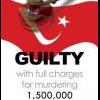Հայկ, Հայգ or Հայք, the plural of Hay/Հայ?
We will see.
In case the below JPG does not appear click here. Can someone please insert that image here so it won'rt be eventually erased. I don't know how
http://upload.wikime...Hayk_statue.JPG

From Martiros Kavoukjian’s (?)** Armenia and Subartu translated by Nourhan Ouzounian. Thank you!
When one reads Martiros’ original text one gets more confused as to which comes first A (Ar-Ra)or H(Haik.). It is obvious that we need more research to determine which is first C or E, chicken or the egg. It does not take a genius to see that in any dictionary C comes before E. In the meantime, we have been running about like a “chicken with its head cut off”. Which is our “head” ? Ara,/ Arev , the Egyptian Ra or Hayk the Hay?
Mr. Ouzounian (thank you again) has chosen to leave some critical points that Martiros advances to which we will come eventually.
HYEK
The god Hyek(Hayk), the mighty archer, has been closely interwoven with the life of the Armenian people since times immemorial, as ancient perhaps as the hunting stage of the primeval communal society.
He was the principal indigenous deity of the most prominent (central)group of the Nairian tribes that have formed the Armenian people.We know that Hyek(Hayk) is none other than Haldi,and that Hyek-Haldi was a deity of fire who had taken origin from the volcanic nature of the Armenian Highland.
As mentioned earlier, Movses Khorenantsi,drawing his information from Mar Aba's book, uses a distinctive expression for Hyek:"the Yapetostean Hayk",i.e. having the nature of Yapetos-Hephaestus.Remembering that Hephaestus was a god of fire, such a characterization of Hyek appears to have taken place during the Hellenistic(Artashessian)period of Armenia when Hyek's fiery nature was still remembered.
Personified as the eponymic ancestor of the Armenian people, Hyek is also described as having "very curly hair and sparkling eyes",a description that was inspired by his fiery nature and paralleled with that given to Vahagn who, too "had hair of fire...and his eyes were two suns."
In the old genealogical list preserved by Khorenatsi, Hyek is considered the son of Torgom. The origin of this name is linked with that of the city-land of Tarkuma/Tarhigama(some scholars locate this city in Hyeasa, but others who place it in the south-western regions of the Armenian Highland((see Tarkuma)), in Arme-Subaria, north of Syria(see Tarhigamani), seem to be more correct. In this connection, it might be right to point out the village of Derik, below Angel Tun-the birthplace of Angls or English, in the region of the sources of the Khabur, 40km west of Mardin.As we have seen before, Adad-Nirari-2 called this region Hark'((Harki)) which was in Armani as mentioned by Naram-Sin)mentioned in Hittite and Urartian inscriptions.
It must be recalled that Hyek is a deity, hence, he should have been considered the son of the god Tarku, the god Tork' of Armenians, whose name is radical component of the city name of Tarkuma/Tarhigama.Tork's main temple was in Aghtznik(Arme-Subaria), at the Armenian sacred city-fortress Angel-Tun(Ingalava?), now called Egil.
Among Armenians Tork 'was also called Tork'Angel; Khorenatsi refers to him as Tork'of Angel, i.e.Tork' of Angelian descent.In the Old Armenian translation of the Bible, the god of the Underworld, Nergal of the Semitic text, is translated as Angel(who probably corresponds also to the Sumerian Engur, the god of the Abyss).
Thus it becomes easier to understand why Hyek, the god of volcano(later attributed to Vahagn) is called "son of Torgom", i.e. the son of Angelian Tork,'the god of the Underworld, because both the volcano and the god of volcano originate from the underworld forces.
The epic of Hyek's fight against Bel(babylonian god) provides a substantial proof that Hyek and his people were already in existance in the land called Hark', at the center of the Armenian-Nairian Highland, at the time when Bel was carrying out his raids, that is, when the mighty Assyro-Babylonian empire was seeking to expand; a proof which, unfortunately, has been overlooked by those who (wrongly)support the theory of migration of Armenian people from the Balkans.
These were the people of Haldi-Hyek, who, as the natives of their own highland, have fought long and bloody battles to protect their homeland against foreign invasions;Because o fthe fact that the Armenian Highland is situated at the crossroads of continents where different civilizations have met, foreign deities have penetrated into the land in later periods, and Hyek, the indigenous god of the land was raised to heaven as a star and identified with the constellation Orion.
AR-ARA
** Can we pleae agree to how to spell his name? Is it Kavoukjian, Gavugjian (damn that turkifying J!)
Edited by Arpa, 23 January 2006 - 03:44 PM.
















